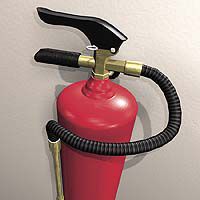Fire is a chemical reaction which requires heat, fuel and oxygen to occur. In the fire service, we define fire as the rapid oxidation of a substance which yields heat and light. Basically, heat causes most substances to release gasses, which when combined with oxygen and heat can produce fire.
Fires are separated into four basic class types or classes, for fire extinguisher use and classification:
•Class A fires.These fires involve paper, wood and other ordinary combustibles.
•Class B fires. These fires involve flammable liquids, such as oil and gasoline.
•Class C fires.These fires involve energized electrical equipment, such as power tools, wiring, fuse boxes, appliances, electronics and electric motors.
•Class D fires.These fires involve combustible metals such as magnesium, aluminum and titanium. These fires are generally not encountered by homeowners.
Fire extinguisher ratings can be confusing for the layman, so here is a basic overview based upon class of fire:
•Class A. Ratings in this class are based upon how much the water equivalent is and range from 1A to 40A. 1A is equivalent to 1.25 gallons of water and A2A is equivalent to 2.5 gallons of water or twice as much as 1A and so on.
March 29 fire safety education evening•Information on portable fire extinguishers |
•Class B. Ratings are based upon the approximate square foot area of flammable liquid that a non-expert operator can extinguish. The ratings range from 1B – which will extinguish approximately 1 square foot of surface fire to 640B – which will extinguish approximately 640 square feet of surface fire.
•Class C. There is no established rating for Class C extinguishers. Class C fires are essentially Class A or B fires on energized electrical equipment.
•Class D. Ratings for Class D fires vary widely based upon the type metal and the type of extinguishing medium. Recently, industry has developed a wet chemical extinguishing medium which will extinguish grease fires and not allow re-ignition of the grease. This type of extinguisher is called a Type K extinguisher. Any business which uses grease or produces grease laden fumes is required by law to have a K-type sprinkler system installed over the cooking apparatus.
Fire extinguishers use a variety of chemicals to extinguish fires. These chemicals have a wide range of applications. Water is a basic extinguishing agent. Water generally cools the fire in order to stop the chain reaction, but it is a poor choice for use on Class-C fires (electrical). There are a variety of foam solutions, inert gasses and dry chemicals used in fire extinguishers today. Each of these chemicals has particular features for specific and general applications. Seek the advice of a fire extinguisher technician or your local fire department for advice.
The first step in choosing a fire extinguisher is to determine what type of fire and how large of a fire may be encountered. Many modern fire extinguishers are rated for two or three types of fires, which makes the selection easier, these are referred to as multi-purpose extinguishers. Most experts recommend an extinguisher with a minimum rating of 2-A, 10-B, C for home use. This marking indicates the extinguisher is acceptable for Class A, B and C fires. It also indicates a non expert will have the equivalent of 2.5 gallons of water for a Class-A fire, 10 square feet coverage for a Class-B fire and it is acceptable for Class C fires. Make sure to read the label for all extinguishers for its class suitability. Most Businesses are required to have extinguishers rated at a minimum of 2-A or 2-A, 20-B, C, depending on the business type.
Regardless of the type of fire extinguisher purchased, it should be maintained and inspected by a licensed professional. Many home owners purchase fire extinguishers and take no thought to regularly check them thinking they are prepared. Since each extinguisher has specific maintenance guidelines, residents will need to refer to the owner’s manual. It can be a fatal mistake to place a person near a small fire and have an extinguisher which doesn’t work.
The choice to use an extinguisher or to get out of a structure is actually a simple one. Portable fire extinguishers are to be used for small trash can size fires after the building has been evacuated and the fire department has been notified. Many people overestimate the capabilities of a small portable fire extinguisher. Remember, property can be replaced but lives cannot. If unsure of how or when to use a fire extinguisher, don’t attempt to extinguish the fire without help. Every year we read of deaths which occur when untrained people try to fight fires. Remember, most fire related deaths occur as a result of smoke inhalation not fire.
In conclusion, remember smoke alarms can and do save lives, but like fire extinguishers; they also need to be checked regularly. Change smoke alarm batteries at least twice a year and have regular fire drills to train your family or co-workers how to quickly and safely exit the home or business. If you cannot afford a smoke alarm, or if you have any questions about fire safety, please call the Price Fire Department at (435)636-3187.
The Price Fire Department will be having a fire education event on March 29. It will take place on Main Street in downtown Price. The event begins at 6 p.m.

